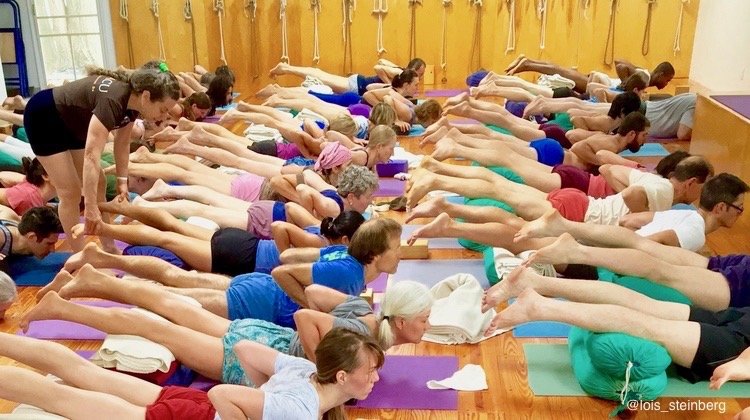Categories of Yoga Postures
Standing poses - Utthistha Sthiti - correct carriage and improve balance, creating lightness in the body and agility in the mind. They shape, and strengthen the leg and arm muscles and decrease stiffness in the legs, hips, and shoulders. This category of postures alleviates back and shoulder aches. The feet become supple, the ankles are strengthened, and the chest expands fully. Practice of the standing postures invigorates the abdominal organs, increases peristaltic activity, aids elimination, and increases the blood supply to the spine. Mastery of these poses increases stamina and prepares the student for all the other categories of poses.
Seated postures - Upavistha Sthiti - benefit reproductive organs and the urinary system, and relieve menstrual irregularities. They benefit pain and/or stiffness in the joints of the lower limbs. Practice of seated poses quiets the mind and reduces anxiety, tension, and mental stress.
Forward bends - Paschima Pratana Sthiti - loosen the joints and lengthen the muscles of the upper and lower extremities. They make the spine elastic. Blood flow is increased in the pelvis, which benefits the digestive, reproductive and eliminative organs. Practice of these poses tones the liver, kidneys, intestines, spleen, and aids digestion. Circulation to the pituitary, pineal, thyroid, and parathyroid glands is improved, and the adrenal glands and pancreas become healthy. Forward bends soothe the nerves, reduce stress and remove mental and physical fatigue.
Twists - Parvritta Sthiti - increase lateral movement of the spine and blood supply to the region of the disks. They relieve neck and shoulder pain, tension, stiffness, and reduce fluid in the sinus passages and ear canal. Backache may also be alleviated with the practice of lateral extensions.
Inversions - Viparita Sthiti - increase circulation around the neck and chest, facilitating healthy blood flow through the brain, including the pituitary and pineal glands. All of the organic systems of the body, including the endocrine and lymphatic systems, benefit from inversions. They improve sleep, memory, and vitality when practiced regularly by developing the body, quieting the mind, and lifting the spirit.
Backward bends - Purva Pratana Sthiti - invigorate the spine, and keep the body alert and supple. They strengthen the arms and legs and have a soothing effect on the head. The pelvic region is opened, the abdominal muscles and chest are lengthened and strengthened, and the reproductive organs are kept healthy. The diaphragm is opened and the heart is gently massaged to help to strengthen it. Practice of backbends enhances vitality, energy, and lightness.





